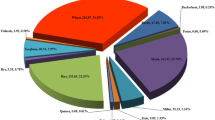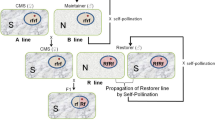Abstract
The practical utilization of heterosis in crop plants has been greatly facilitated during the past 15 years by the use of cytoplasmic male|sterility for low-cost, large-scale emasculation of the seed parents of hybrids. The method is now being used in commercial production of hybrid onions, sugar beets, field corn, grain sorghum, and petunias. Its use is contemplated for hybrid sweet corn, pop corn, red table beets, fodder beets, fodder sorghum, pearl millet, carrots, and garden peppers.
Similar content being viewed by others
Literature Cited
Anon. Hybrid Onions. Agric. Res. Serv. Special Report 22–24, U.S.D.A. May, 1956.
Baker, R. F. Personal communication. Dec. 1, 1958.
Banga, O. Personal communication. Nov. 13, 1958.
—. Breeding male sterile lines of Dutch onion varieties as a preliminary to the breeding of hybrid varieties. Euphytica7: 21–30. 1958.
Barham, W. S., and H. M. Munger. The stability of male sterility in onions. Proc. Amer. Soc. Hort. Sci.56: 401–409. 1950.
Bateson, W., and A. E. Gairdner. Male sterility in flax subject to two types of segregation. Jour. Genet.11: 269–275. 1921.
Bogh, Henrik. Personal communication. Oct. 13, 1958.
Briggle, L. W. Interactions of cytoplasm and genes in a group of male sterile corn types. Agron. Jour.49: 543–547. 1957.
Brown, W. L. (In audience discussion section of reference 50).
Buchert, J. F. Personal communication. Nov. 20, 1958.
Burton, G. W. Cytoplasmic male-sterility in pearl millet(Pennisetum glaucum)(L.) R. Br. Agron. Jour.50: 230–231. 1958.
-. Personal communication. Dec. 19, 1958.
Chittendon, R. J., and C. A. Pellew. A suggested interpretation of certain cases of anisogeny. Nature119: 10–12. 1927.
Clayton, E. E. Male sterile tobacco. Jour. Hered.41: 171–175. 1950.
-. Personal communication. Sept. 13, 1958.
Correns, C. Experimentelle Untersuchungen über die Gynodioecie. Ber. Deut. Bot. Ges.22: 506–517. 1940. Cited by Edwardson, J. R. Experimentelle Untersuchungen über die Gynodioecie in Bot. Rev.22: 696-738. 1956.
Culbertson, J. O. Personal communication. Nov. 3, 1958.
Davis, E. W. The distribution of the malesterility gene in onion. Proc. Amer. Soc. Hort. Sci.70: 316–318. 1957.
—. Male-sterility in onion plants from Turkey. Jour. Hered. XLIX: 31–32. 1958.
-. Personal communication. Nov. 13, 1958.
Dickenson, D. D. Personal communication. Jan. 13, 1959.
Duvick, D. N. Allelism and comparative genetics of fertility restoration of cytoplasmically pollen sterile maize. Genetics41: 544–565. 1956.
—. Yields and other agronomic characteristics of cytoplasmically pollen sterile corn hybrids, compared to their normal counterparts. Agron. Jour.50: 121–125. 1958.
—. Characterization of sterility-inducing cytoplasms. Maize Gen. Coop. Newsletter32: 119. 1958.
-. Unpublished data.
East, E. M. Studies of self-sterility. IX. The behavior of crosses between selfsterile and self-fertile plants. Genetics17: 175–202. 1932.
—. The nucleus-plasma problem. Amer. Nat.68: 289–303, 404-439. 1934.
Eckhardt, R. C. Techniques in using male sterile cytoplasm and a restorer gene in corn. (Abstract). Annual Meeting American Soc. of Agron. 1954.
Edwardson, J. R. The restoration of fertility to cytoplasmic male-sterile corn. Agron. Jour.47: 457–461. 1955.
Everett, H. L. Personal communication. Dec. 17, 1958.
Fukasawa, H. Studies on restoration and substitution of nucleus ofAegilotricum,I. Appearance of male-steriledurum in substitution crosses. Cytologia18: 167–175. 1953.
—. Studies on restoration and substitution of nucleus (genome) inAegilotricum,II. The inter-relationships betweenovata cytoplasm and fertility restoring factors. Cytologia20: 211–217. 1955.
-. Chlorophyll variegation which appeared in male-sterile Emmer wheat. Wheat Inform. Serv. No. 3, p. 19. 1956.
—. Studies on restoration and substitution of nucleus (Genome) inAegilotricum, III. Cyto-histological investigation of pollen degeneration in anthers of male-sterile plants. Cytologia21: 97–106. 1956.
—. Studies on restoration and substitution of nucleus (genome) inAgrilotricum,IV. Genome exchange betweendurum andovata cytoplasm and its theoretical consideration for male sterility. Cytologia22: 30–39. 1957.
—. Studies on restoration and substitution of nucleus (genome) inAegilotricum,VI. Some conspicious characters appearing in male-sterile Emmer wheats. Jap. Jour. Genetics32: 313–322. 1957.
-. Fertility restoration of cytoplasmic male-sterile Emmer wheats. Wheat Inform. Serv. No. 7, p. 21. 1958.
-. Personal communication. Dec. 8, 1958.
Gabelman, W. H. Male sterility in vegetable breeding. Genetics in Plant Breeding, Brookhaven Symposia in Biology9: 113–122. 1956.
-. Personal communication. June 25, 1958.
Goldsmith, G. A. Personal communication. Sept. 29 and Dec. 18, 1958.
Haber, E. S. Personal communication. Nov. 18, 1958.
Haigh, J. C. Personal communication. Dec. 11 and Dec. 31, 1958.
Hayes, H. K., F. R. Immer and D. C. Smith. Methods of Plant Breeding. McGraw-Hill Book Co., Inc., New York. 1955.
Hendrikson, A. J. Th. Personal communi cation. Sept. 19, 1958.
Hogaboam, G. J. Factors influencing phenotypic expression of cytoplasmic male sterility in the sugar beet (Beta vulgaris, L.). Jour. Amer. Soc. Sugar Beet Tech.IX: 457–465. 1957.
Jenkins, B. C. Personal communication. Oct. 8, 1958.
Jones, D. F. The interrelation of plasmagenes and chromogenes in pollen production in maize. Genetics35: 507–512. 1950.
—. The cytoplasmic separation of species. Proc. Nat. Acad. Sc. (U.S.)37: 408–410. 1951.
—. Genic and cytoplasmic control of pollen abortion in maize. Genetics in Plant Breeding, Brookhaven Symposia in Biology9: 101–112. 1956.
-. Personal communication. Dec. 2, 1958.
- and H. L. Everett. Hybrid Field Corn. Conn. Agric. Exp. Sta. Bull. 532. 1949.
- and P. C. Mangelsdorf. The production of hybrid corn seed without detasseling. Conn. Agric. Exp. Sta. Bull. 550. 1951.
-, H. T. Stinson, Jr., and U. Khoo. Pollen Restoring Genes. Conn. Agric. Exp. Sta. Bull. 610. 1957.
-, H. T. Stinson, A. P. Munson and C. C. Renshaw. Field and sweet corn report for 1954. Report of Progress Gl. Dept. of Gen., Conn. Agric. Exp. Sta. Feb., 1955. Mimeo.
Jones, H. A. Personal communication. Sept. 23, 1958.
—. Inheritance of male sterility in the onion and the production of hybrid seed. Proc. Amer. Soc. Hort. Sci.43: 189–194. 1943.
— A male-sterile onion. Proc. Amer. Soc. Hort. Sci.34: 582–585. 1937.
—. Breeding for resistance to onion downy mildew caused byPeronospora destructor. Hilgardia12: 531–550. 1939.
Josephson, L. M. and M. T. Jenkins. Male sterility in corn hybrids. Jour. Amer. Soc. Agron.40: 267–274. 1948. See also Maize Genetics Cooperation News Letter, March 1, 1947.
Kehr, A. E. Personal communication. Oct. 29, 1958.
Kidd, H. Personal communication. Sept. 21, 1958.
Kihara, H. Substitution of nucleus and and its effects on genome manifestations. Cytologia16: 177–193. 1951.
Koopmans, A. Changes in sex in the flowers of the hybridSolatium, Rybinii xS. Chacoense. Genetica26: 359–380. 1952.
Kuckuck, H. Personal communication. Dec. 11, 1958.
Lamm, R. Investigations on some tuberbearingSolatium hybrids. Hereditas39: 97–112. 1953.
Little, T. M., H. A. Jones and A. E. Clarke. The distribution of the malesterility gene in varieties of onion. Herbertia11: 310–312. 1944.
Lonnquist, T. L. Personal communication. May 1, 1958.
Lowe, J. Personal communication. Jan. 2, 1959.
Maunder, A. B. Personal communication. Dec. 29, 1958.
—. The genetic inheritance of cytoplasmic-genetic male sterility in grain sorghum. Agron. Jour.51: 47–49. 1959.
Mizushima, U. Personal communication. Dec. 10, 1958.
—. Elimination of selfincompatibility in the common cabbage,Brassica oleracea L., by means of substitution of nucleus. (Abstract). Proc. X. Internat. Cong. Gen. Vol. II, p. 191. 1958.
Myers, W. M. Effects of cytoplasm and gene dosage on expression of malesterility inDactylis glomerata. (Abstract). Genetics31: 225–226. 1946.
-. Personal communication. Dec. 29, 1958.
Oldenmeyer, R. K. Sugar beet male sterility. Jour. Amer. Soc. Sugar Beet Tech.IX: 381–386. 1957.
-. Personal communication. Nov. 25, 1958.
Owen, F. V. Male sterility in sugar beets produced by complementary effects of cytoplasmic and Mendelian inheritance. (Abstract). Amer. Jour. Bot.29: 692. 1942.
—. Cytoplasmically inherited malesterility in sugar beets. Jour. Agric. Res.71: 423–440. 1945.
-. Utilization of male sterility in breeding superior-yielding sugar beets. Proc. Amer. Soc. Sugar Beet Tech. pp. 156-161. 1948.
-. The sugar beet breeder's problem of establishing male-sterile populations for hybridization purposes. Proc. Amer. Soc. Sugar Beet Tech. pp. 191-194. 1950.
-. Mendelian male sterility in sugar beets. Proc. Amer. Soc. Sugar Beet Tech. pp. 371-376. 1952.
-. Hybrid sugar beets made by utilizing both cytoplasmic and Mendelian male sterility. Proc. Amer. Soc. Sugar Beet Tech. VIII, Part II: 64. 1954.
-. Personal communication. Nov. 17, 1958.
-, A. M. Murphy and G. K. Ryser. Inbred lines from curly-top-resistant varieties of sugar beets. Proc. Amer. Soc. Sugar Beet Tech. 246-252. 1946.
—. Preliminary yield tests with F1 male-sterile monogerm hybrid sugar beets. Proc. Amer. Soc. Sugar Beet Tech. VIII, Part II: 45–48. 1954.
Parkey, W. Cytoplasmic influence in the production of the pistillate sex expression in castorbeans. Agron. Jour.49: 427–428. 1957.
Peterson, C. E. and R. L. Foskett. The occurrence of pollen sterility in seed fields of Scott County Globe onions. Proc. Amer. Soc. Hort. Sci.62: 443–448. 1953.
Peterson, P. A. Cytoplasmically inherited male sterility inCapsicum. The American Naturalist. XCII: 111–119. 1958.
-. Personal communication. Oct. 29, 1958.
Quinby, J. R. and J. H. Martin. Sorghum Improvement. Advances in Agronomy VI, A. G. Norman, Ed. Academic Press Inc., 1954.
-, N. W. Kramer, J. C. Stephens, K. A. Lahr and R. E. Karper. Grain sorghum production in Texas. Tex. Agric. Exp. Sta. Bull. 912, in coop, with U.S.D.A. 1958.
Raghavan, T. S. Cytoplasmic inheritance inSaccharum. Cur. Sci.20: 138–140. 1951.
Rhoades, M. M. Cytoplasmic inheritance of male sterility inZea mays. Science73: 340–341. 1931.
—. The cytoplasmic inheritance of male sterility inZea mays. Jour. Genetics27: 71–95. 1933.
—. Gene induced mutation of a heritable cytoplasmic factor producing male sterility in maize. Proc. Nat. Acad. Sci, (U.S.)36: 634–635. 1950.
-. Origin of cytoplasmic male sterility in corn. American Seed Trade Assoc. Sixth Hybrid Corn Industry-Research Conference. 1951.
-. (In audience discussion section of reference 50).
Rick, C. M. Rates of natural cross-pollination of tomatoes in various localities in California as measured by the fruits and seeds set of male-sterile plants. Proc. Amer. Soc. Hort. Sci.54: 237–252. 1949.
Rogers, J. S., in: Report of the Eighth Southern Corn Improvement Conference, (p. 12) Aug., 1949. Mimeo. Dec, 1950.
- in: Report of the Ninth Southern Corn Improvement Conference, (pp. 23-25). Aug., 1950. Mimeo. Dec, 1950.
—. The utilization of cytoplasmic male-sterile inbreds in the production of corn hybrids. Agron. Jour.44: 8–13. 1952.
Ross, W. M. Personal communication. Dec. 19, 1958.
Sampath, S. Personal communication. Dec. 29, 1958.
—. Cytology of semisterile rice hybrids. Cur. Sci.23: 182–183. 1954.
Savitsky, V. F. Methods and results of breeding work with monogerm beets. Proc. Amer. Soc. Sugar Beet Tech. 344-350. 1952.
-Savitsky, V. F.. Differences in interaction of cytoplasm-genes, in different male-sterile races inBeta vulgaris L. (abstract). Proc. X Internat. Congr. Genetics. Vol. II. p. 251. 1958.
Sears, E. R. Personal communication. Sept. 16, 1958.
Smith, J. D. Personal communication. Dec. 8, 1958.
Sprague, G. F. Personal communication. Nov. 6, 1958.
Statt, F. Personal communication. Sept. 30, 1958.
Stephens, J. O. Personal communication. Nov. 19, 1958.
—. Cytoplasmic male-sterility for hybrid sorghum seed production. Agron. Jour.46: 20–23. 1954.
Stringfield, G. H. Fertility restoration and yields in maize. Agron. Jour.50: 215–218. 1958.
Thomas, W. I. Personal communication. Dec. 11, 1958.
—. Inheritance of pollen restoration and transmission of cytoplasmic sterility in popcorn. Agron. Jour.48: 472–474. 1956.
Tolman, Bion. Personal communication. Oct. 10, 1958.
Trotter, A. R. Personal communication. Sept. 25, 1958.
U. S. Patent No. 2, 753,663, issued July 10, 1956 (application April 10, 1950) to Donald F. Jones, assignor to Research Corporation, New York, N. Y.
von Wettstein, F. Morphologie und Physiologie des Formwechsels der Moose auf genetischer Grundlage. I. Zeits. Ind. Abst. Vererb.33: 1–236. 1924. Cited by Edwardson, J. R. Morphologie und Physiologie des Formwechsels der Moose auf genetischer Grundlage in Bot. Rev. 22: 696-738. 1956.
Welch, J. E. Personal communication. Oct. 31, 1958.
— and E. L. Grimball Male sterility in the carrot. Science106: 594. 1947.
Author information
Authors and Affiliations
Rights and permissions
About this article
Cite this article
Duvick, D.N. The use of cytoplasmic male-sterility in hybrid seed production. Econ Bot 13, 167–195 (1959). https://doi.org/10.1007/BF02860581
Issue Date:
DOI: https://doi.org/10.1007/BF02860581




